Report on Hilton Hotel's Web Business Model and Marketing Strategy
VerifiedAdded on 2022/10/04
|11
|2581
|17
Report
AI Summary
This report provides a comprehensive analysis of Hilton Hotel's web business model, delving into its target market, site analysis, and internet marketing strategies. It examines the company's customer base, potential target markets, and competitive landscape, including brands like Hyatt and Marriott. The report explores Hilton's communication mix, particularly advertising and public relations, and assesses the impact of the internet on its marketing mix, focusing on product presentation and promotional offers. It highlights the importance of social listening and customer interaction in Hilton's digital marketing approach, emphasizing the company's commitment to customer service and brand equity. The analysis concludes with an evaluation of the effectiveness of Hilton's digital marketing strategies in the context of a competitive online environment.

Paraphrase This Document
Need a fresh take? Get an instant paraphrase of this document with our AI Paraphraser
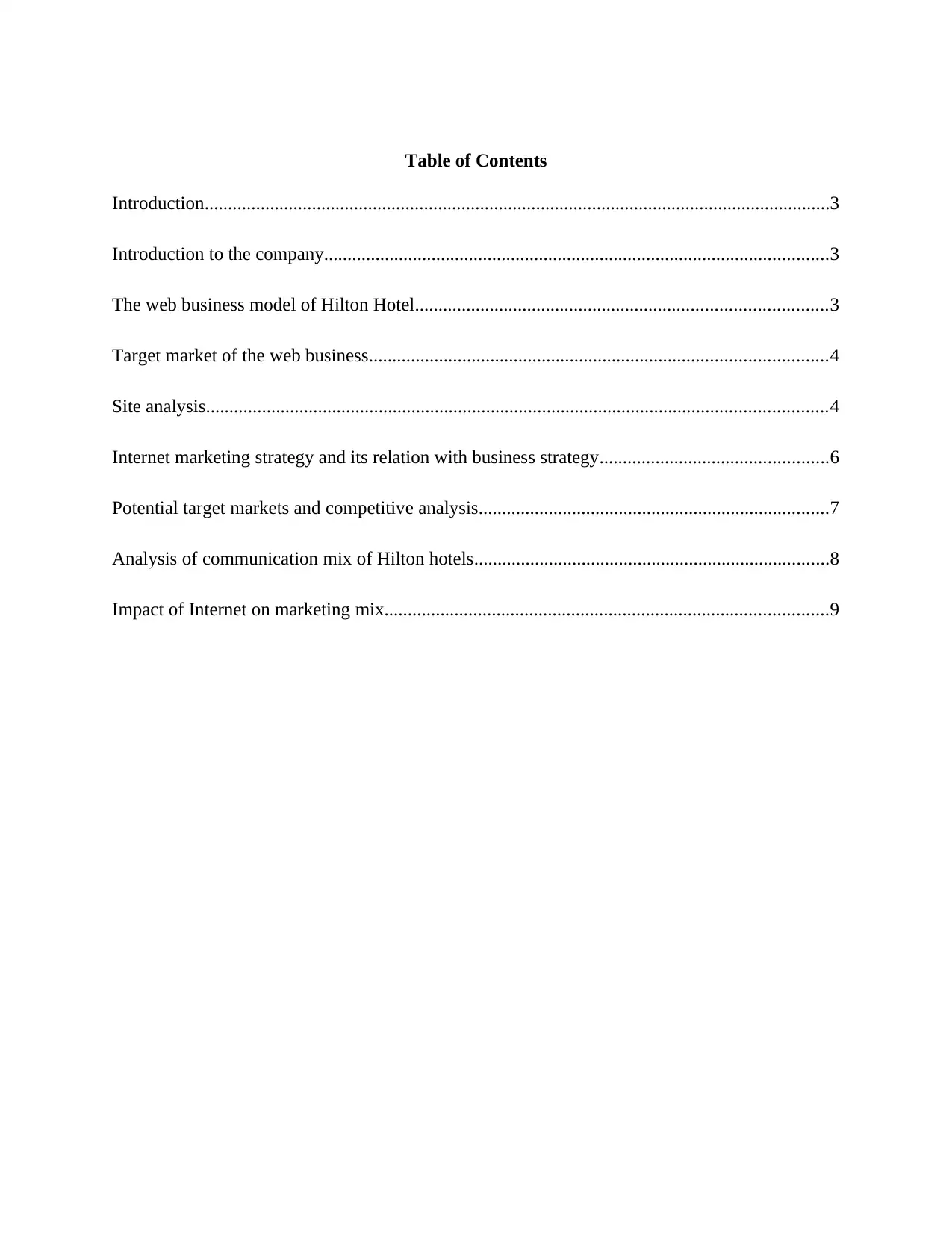
Table of Contents
Introduction......................................................................................................................................3
Introduction to the company............................................................................................................3
The web business model of Hilton Hotel........................................................................................3
Target market of the web business..................................................................................................4
Site analysis.....................................................................................................................................4
Internet marketing strategy and its relation with business strategy.................................................6
Potential target markets and competitive analysis...........................................................................7
Analysis of communication mix of Hilton hotels............................................................................8
Impact of Internet on marketing mix...............................................................................................9
Introduction......................................................................................................................................3
Introduction to the company............................................................................................................3
The web business model of Hilton Hotel........................................................................................3
Target market of the web business..................................................................................................4
Site analysis.....................................................................................................................................4
Internet marketing strategy and its relation with business strategy.................................................6
Potential target markets and competitive analysis...........................................................................7
Analysis of communication mix of Hilton hotels............................................................................8
Impact of Internet on marketing mix...............................................................................................9
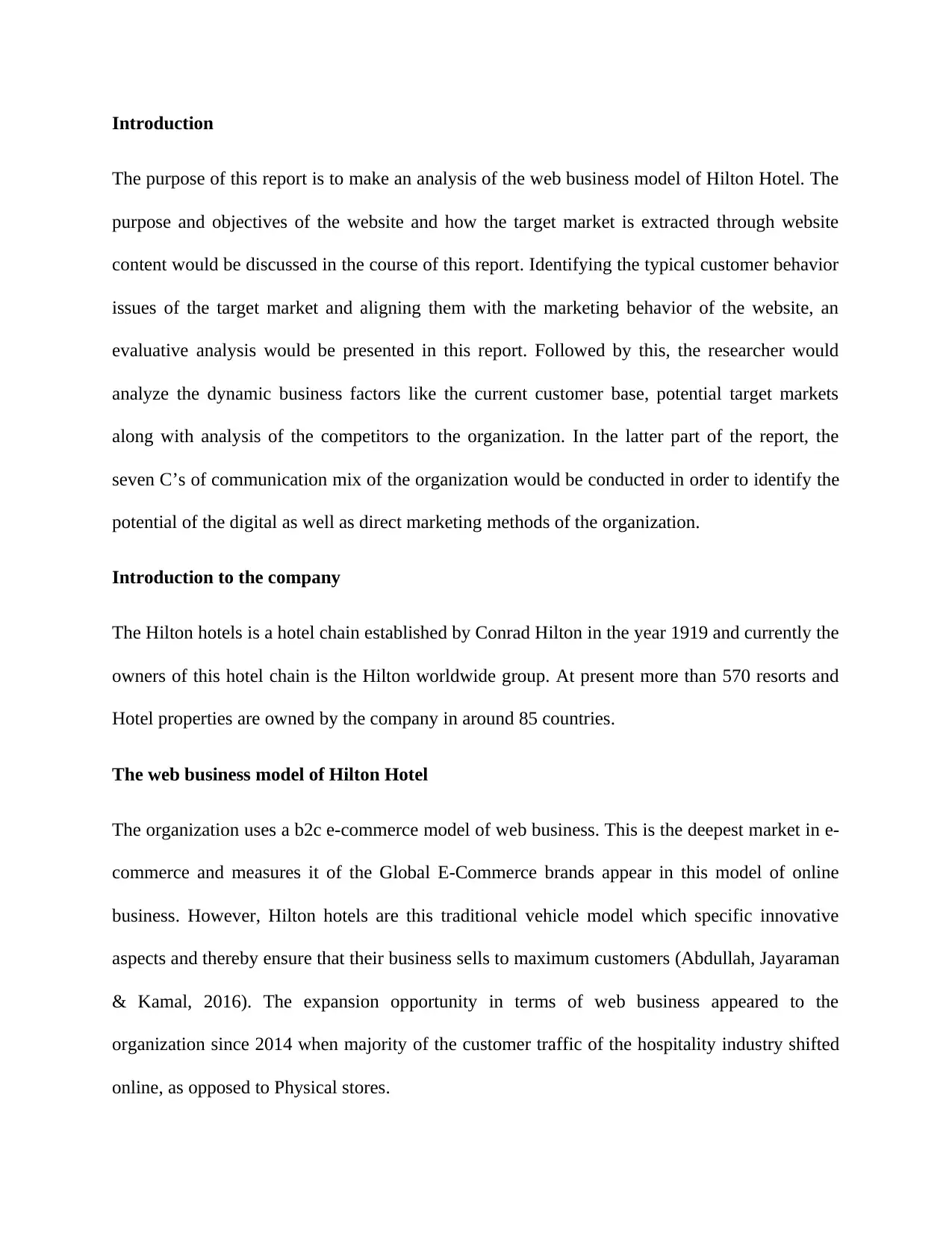
Introduction
The purpose of this report is to make an analysis of the web business model of Hilton Hotel. The
purpose and objectives of the website and how the target market is extracted through website
content would be discussed in the course of this report. Identifying the typical customer behavior
issues of the target market and aligning them with the marketing behavior of the website, an
evaluative analysis would be presented in this report. Followed by this, the researcher would
analyze the dynamic business factors like the current customer base, potential target markets
along with analysis of the competitors to the organization. In the latter part of the report, the
seven C’s of communication mix of the organization would be conducted in order to identify the
potential of the digital as well as direct marketing methods of the organization.
Introduction to the company
The Hilton hotels is a hotel chain established by Conrad Hilton in the year 1919 and currently the
owners of this hotel chain is the Hilton worldwide group. At present more than 570 resorts and
Hotel properties are owned by the company in around 85 countries.
The web business model of Hilton Hotel
The organization uses a b2c e-commerce model of web business. This is the deepest market in e-
commerce and measures it of the Global E-Commerce brands appear in this model of online
business. However, Hilton hotels are this traditional vehicle model which specific innovative
aspects and thereby ensure that their business sells to maximum customers (Abdullah, Jayaraman
& Kamal, 2016). The expansion opportunity in terms of web business appeared to the
organization since 2014 when majority of the customer traffic of the hospitality industry shifted
online, as opposed to Physical stores.
The purpose of this report is to make an analysis of the web business model of Hilton Hotel. The
purpose and objectives of the website and how the target market is extracted through website
content would be discussed in the course of this report. Identifying the typical customer behavior
issues of the target market and aligning them with the marketing behavior of the website, an
evaluative analysis would be presented in this report. Followed by this, the researcher would
analyze the dynamic business factors like the current customer base, potential target markets
along with analysis of the competitors to the organization. In the latter part of the report, the
seven C’s of communication mix of the organization would be conducted in order to identify the
potential of the digital as well as direct marketing methods of the organization.
Introduction to the company
The Hilton hotels is a hotel chain established by Conrad Hilton in the year 1919 and currently the
owners of this hotel chain is the Hilton worldwide group. At present more than 570 resorts and
Hotel properties are owned by the company in around 85 countries.
The web business model of Hilton Hotel
The organization uses a b2c e-commerce model of web business. This is the deepest market in e-
commerce and measures it of the Global E-Commerce brands appear in this model of online
business. However, Hilton hotels are this traditional vehicle model which specific innovative
aspects and thereby ensure that their business sells to maximum customers (Abdullah, Jayaraman
& Kamal, 2016). The expansion opportunity in terms of web business appeared to the
organization since 2014 when majority of the customer traffic of the hospitality industry shifted
online, as opposed to Physical stores.
⊘ This is a preview!⊘
Do you want full access?
Subscribe today to unlock all pages.

Trusted by 1+ million students worldwide
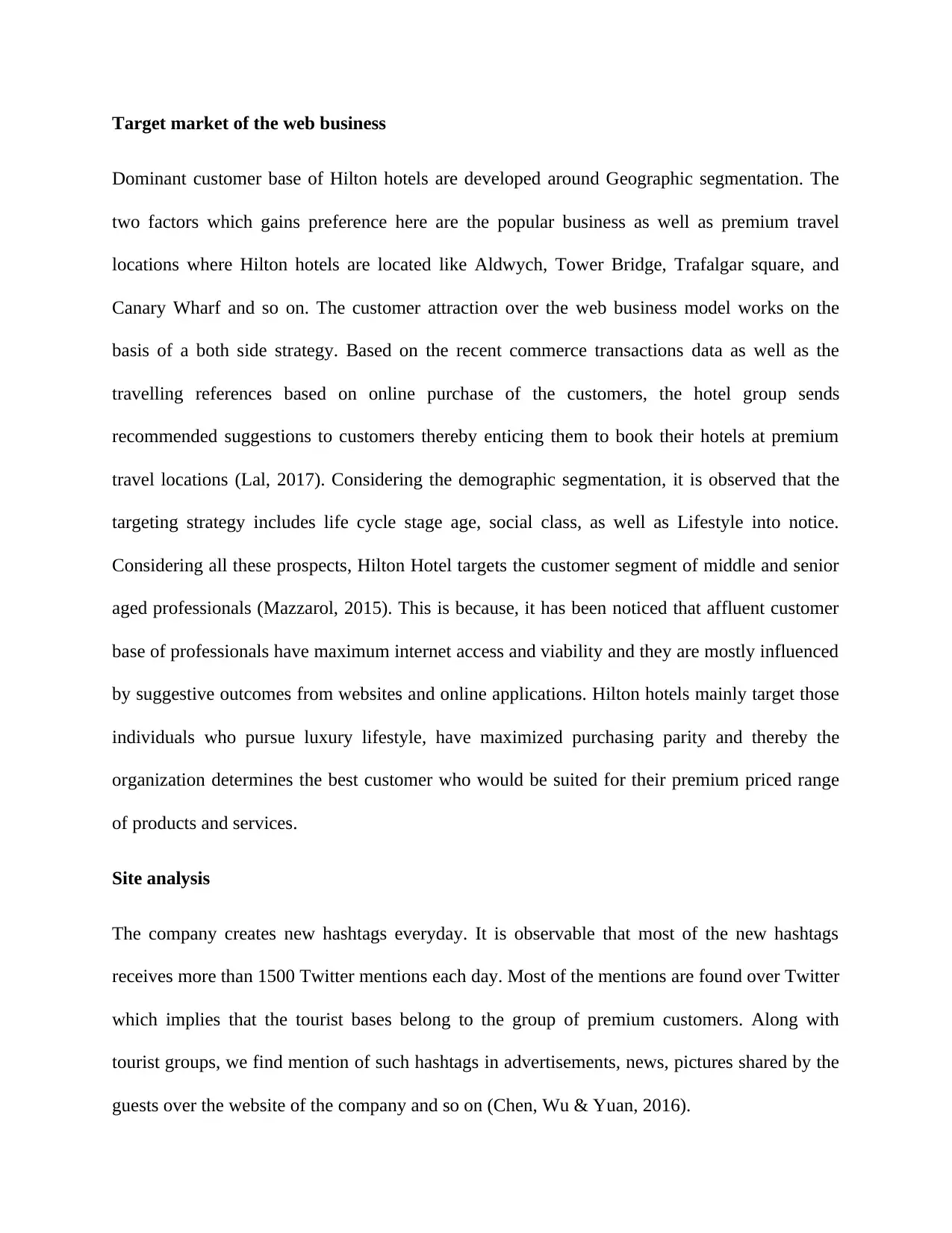
Target market of the web business
Dominant customer base of Hilton hotels are developed around Geographic segmentation. The
two factors which gains preference here are the popular business as well as premium travel
locations where Hilton hotels are located like Aldwych, Tower Bridge, Trafalgar square, and
Canary Wharf and so on. The customer attraction over the web business model works on the
basis of a both side strategy. Based on the recent commerce transactions data as well as the
travelling references based on online purchase of the customers, the hotel group sends
recommended suggestions to customers thereby enticing them to book their hotels at premium
travel locations (Lal, 2017). Considering the demographic segmentation, it is observed that the
targeting strategy includes life cycle stage age, social class, as well as Lifestyle into notice.
Considering all these prospects, Hilton Hotel targets the customer segment of middle and senior
aged professionals (Mazzarol, 2015). This is because, it has been noticed that affluent customer
base of professionals have maximum internet access and viability and they are mostly influenced
by suggestive outcomes from websites and online applications. Hilton hotels mainly target those
individuals who pursue luxury lifestyle, have maximized purchasing parity and thereby the
organization determines the best customer who would be suited for their premium priced range
of products and services.
Site analysis
The company creates new hashtags everyday. It is observable that most of the new hashtags
receives more than 1500 Twitter mentions each day. Most of the mentions are found over Twitter
which implies that the tourist bases belong to the group of premium customers. Along with
tourist groups, we find mention of such hashtags in advertisements, news, pictures shared by the
guests over the website of the company and so on (Chen, Wu & Yuan, 2016).
Dominant customer base of Hilton hotels are developed around Geographic segmentation. The
two factors which gains preference here are the popular business as well as premium travel
locations where Hilton hotels are located like Aldwych, Tower Bridge, Trafalgar square, and
Canary Wharf and so on. The customer attraction over the web business model works on the
basis of a both side strategy. Based on the recent commerce transactions data as well as the
travelling references based on online purchase of the customers, the hotel group sends
recommended suggestions to customers thereby enticing them to book their hotels at premium
travel locations (Lal, 2017). Considering the demographic segmentation, it is observed that the
targeting strategy includes life cycle stage age, social class, as well as Lifestyle into notice.
Considering all these prospects, Hilton Hotel targets the customer segment of middle and senior
aged professionals (Mazzarol, 2015). This is because, it has been noticed that affluent customer
base of professionals have maximum internet access and viability and they are mostly influenced
by suggestive outcomes from websites and online applications. Hilton hotels mainly target those
individuals who pursue luxury lifestyle, have maximized purchasing parity and thereby the
organization determines the best customer who would be suited for their premium priced range
of products and services.
Site analysis
The company creates new hashtags everyday. It is observable that most of the new hashtags
receives more than 1500 Twitter mentions each day. Most of the mentions are found over Twitter
which implies that the tourist bases belong to the group of premium customers. Along with
tourist groups, we find mention of such hashtags in advertisements, news, pictures shared by the
guests over the website of the company and so on (Chen, Wu & Yuan, 2016).
Paraphrase This Document
Need a fresh take? Get an instant paraphrase of this document with our AI Paraphraser
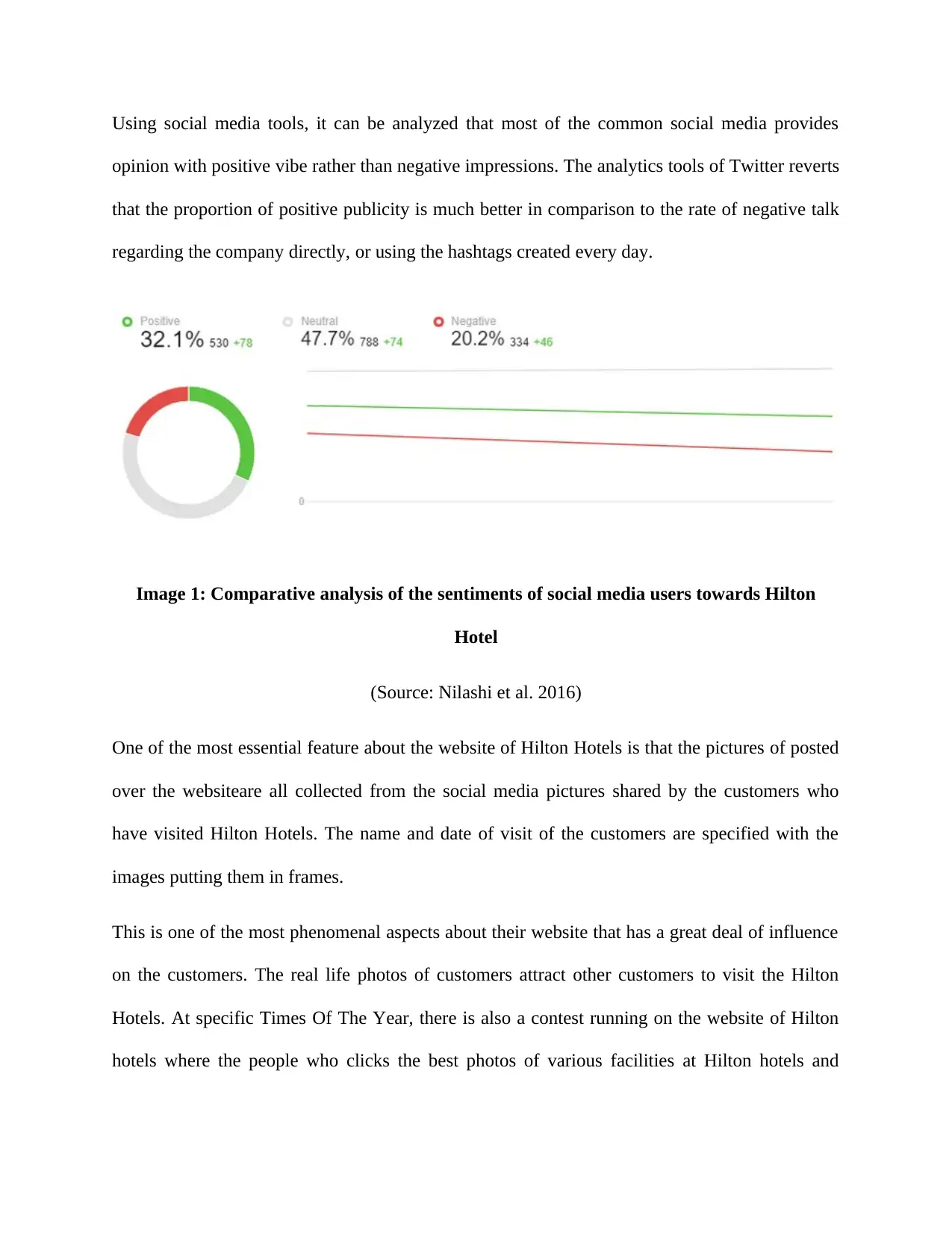
Using social media tools, it can be analyzed that most of the common social media provides
opinion with positive vibe rather than negative impressions. The analytics tools of Twitter reverts
that the proportion of positive publicity is much better in comparison to the rate of negative talk
regarding the company directly, or using the hashtags created every day.
Image 1: Comparative analysis of the sentiments of social media users towards Hilton
Hotel
(Source: Nilashi et al. 2016)
One of the most essential feature about the website of Hilton Hotels is that the pictures of posted
over the websiteare all collected from the social media pictures shared by the customers who
have visited Hilton Hotels. The name and date of visit of the customers are specified with the
images putting them in frames.
This is one of the most phenomenal aspects about their website that has a great deal of influence
on the customers. The real life photos of customers attract other customers to visit the Hilton
Hotels. At specific Times Of The Year, there is also a contest running on the website of Hilton
hotels where the people who clicks the best photos of various facilities at Hilton hotels and
opinion with positive vibe rather than negative impressions. The analytics tools of Twitter reverts
that the proportion of positive publicity is much better in comparison to the rate of negative talk
regarding the company directly, or using the hashtags created every day.
Image 1: Comparative analysis of the sentiments of social media users towards Hilton
Hotel
(Source: Nilashi et al. 2016)
One of the most essential feature about the website of Hilton Hotels is that the pictures of posted
over the websiteare all collected from the social media pictures shared by the customers who
have visited Hilton Hotels. The name and date of visit of the customers are specified with the
images putting them in frames.
This is one of the most phenomenal aspects about their website that has a great deal of influence
on the customers. The real life photos of customers attract other customers to visit the Hilton
Hotels. At specific Times Of The Year, there is also a contest running on the website of Hilton
hotels where the people who clicks the best photos of various facilities at Hilton hotels and
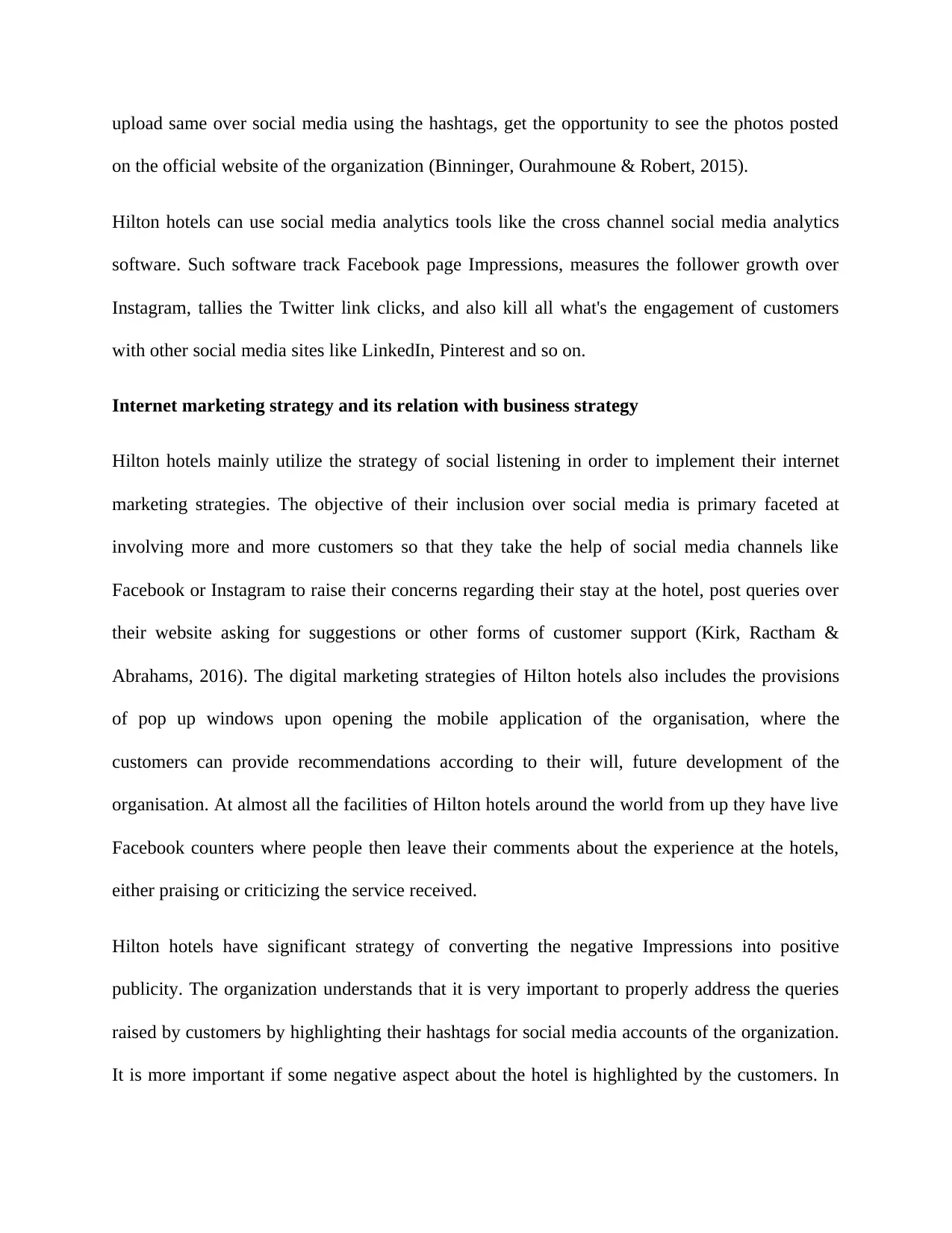
upload same over social media using the hashtags, get the opportunity to see the photos posted
on the official website of the organization (Binninger, Ourahmoune & Robert, 2015).
Hilton hotels can use social media analytics tools like the cross channel social media analytics
software. Such software track Facebook page Impressions, measures the follower growth over
Instagram, tallies the Twitter link clicks, and also kill all what's the engagement of customers
with other social media sites like LinkedIn, Pinterest and so on.
Internet marketing strategy and its relation with business strategy
Hilton hotels mainly utilize the strategy of social listening in order to implement their internet
marketing strategies. The objective of their inclusion over social media is primary faceted at
involving more and more customers so that they take the help of social media channels like
Facebook or Instagram to raise their concerns regarding their stay at the hotel, post queries over
their website asking for suggestions or other forms of customer support (Kirk, Ractham &
Abrahams, 2016). The digital marketing strategies of Hilton hotels also includes the provisions
of pop up windows upon opening the mobile application of the organisation, where the
customers can provide recommendations according to their will, future development of the
organisation. At almost all the facilities of Hilton hotels around the world from up they have live
Facebook counters where people then leave their comments about the experience at the hotels,
either praising or criticizing the service received.
Hilton hotels have significant strategy of converting the negative Impressions into positive
publicity. The organization understands that it is very important to properly address the queries
raised by customers by highlighting their hashtags for social media accounts of the organization.
It is more important if some negative aspect about the hotel is highlighted by the customers. In
on the official website of the organization (Binninger, Ourahmoune & Robert, 2015).
Hilton hotels can use social media analytics tools like the cross channel social media analytics
software. Such software track Facebook page Impressions, measures the follower growth over
Instagram, tallies the Twitter link clicks, and also kill all what's the engagement of customers
with other social media sites like LinkedIn, Pinterest and so on.
Internet marketing strategy and its relation with business strategy
Hilton hotels mainly utilize the strategy of social listening in order to implement their internet
marketing strategies. The objective of their inclusion over social media is primary faceted at
involving more and more customers so that they take the help of social media channels like
Facebook or Instagram to raise their concerns regarding their stay at the hotel, post queries over
their website asking for suggestions or other forms of customer support (Kirk, Ractham &
Abrahams, 2016). The digital marketing strategies of Hilton hotels also includes the provisions
of pop up windows upon opening the mobile application of the organisation, where the
customers can provide recommendations according to their will, future development of the
organisation. At almost all the facilities of Hilton hotels around the world from up they have live
Facebook counters where people then leave their comments about the experience at the hotels,
either praising or criticizing the service received.
Hilton hotels have significant strategy of converting the negative Impressions into positive
publicity. The organization understands that it is very important to properly address the queries
raised by customers by highlighting their hashtags for social media accounts of the organization.
It is more important if some negative aspect about the hotel is highlighted by the customers. In
⊘ This is a preview!⊘
Do you want full access?
Subscribe today to unlock all pages.

Trusted by 1+ million students worldwide
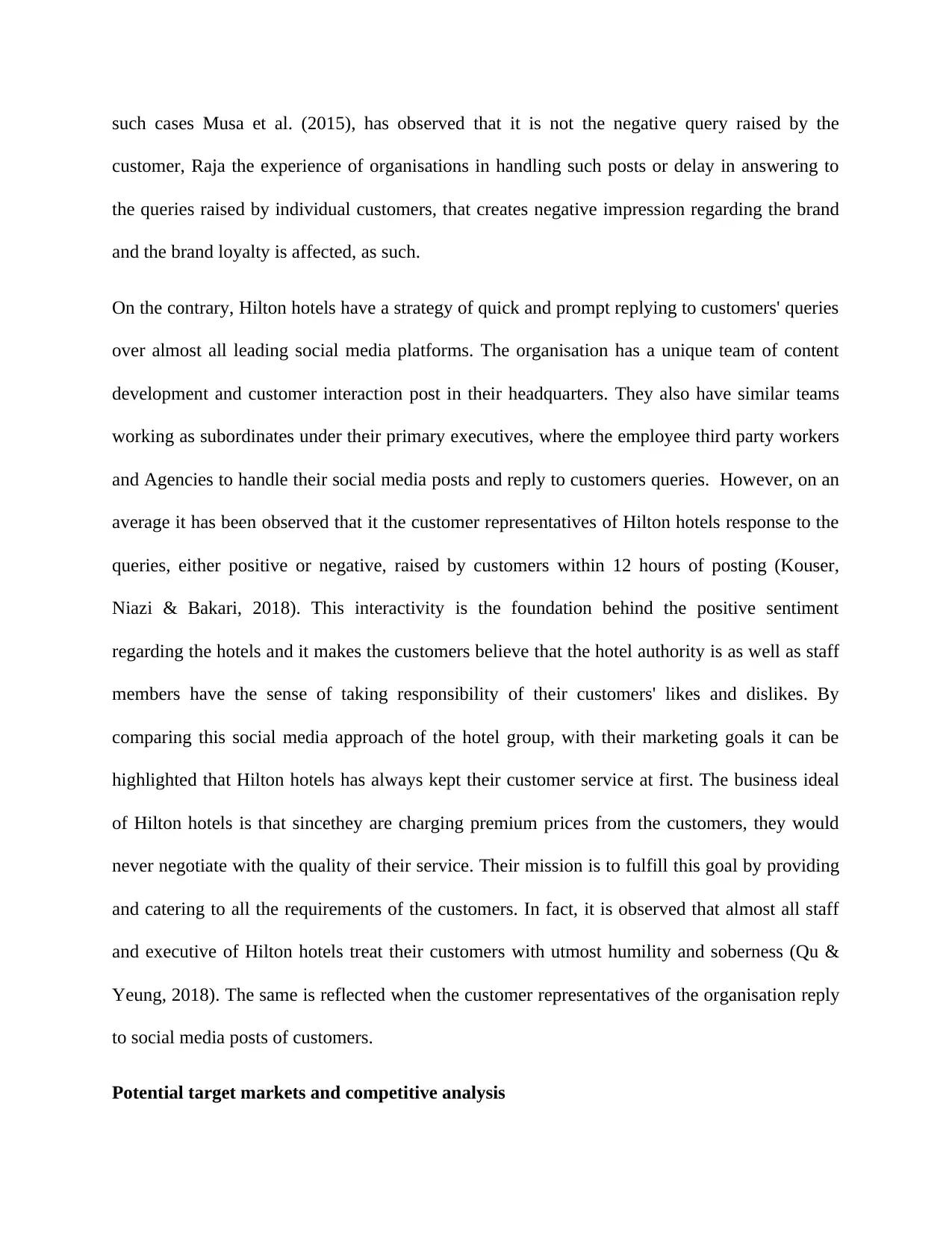
such cases Musa et al. (2015), has observed that it is not the negative query raised by the
customer, Raja the experience of organisations in handling such posts or delay in answering to
the queries raised by individual customers, that creates negative impression regarding the brand
and the brand loyalty is affected, as such.
On the contrary, Hilton hotels have a strategy of quick and prompt replying to customers' queries
over almost all leading social media platforms. The organisation has a unique team of content
development and customer interaction post in their headquarters. They also have similar teams
working as subordinates under their primary executives, where the employee third party workers
and Agencies to handle their social media posts and reply to customers queries. However, on an
average it has been observed that it the customer representatives of Hilton hotels response to the
queries, either positive or negative, raised by customers within 12 hours of posting (Kouser,
Niazi & Bakari, 2018). This interactivity is the foundation behind the positive sentiment
regarding the hotels and it makes the customers believe that the hotel authority is as well as staff
members have the sense of taking responsibility of their customers' likes and dislikes. By
comparing this social media approach of the hotel group, with their marketing goals it can be
highlighted that Hilton hotels has always kept their customer service at first. The business ideal
of Hilton hotels is that sincethey are charging premium prices from the customers, they would
never negotiate with the quality of their service. Their mission is to fulfill this goal by providing
and catering to all the requirements of the customers. In fact, it is observed that almost all staff
and executive of Hilton hotels treat their customers with utmost humility and soberness (Qu &
Yeung, 2018). The same is reflected when the customer representatives of the organisation reply
to social media posts of customers.
Potential target markets and competitive analysis
customer, Raja the experience of organisations in handling such posts or delay in answering to
the queries raised by individual customers, that creates negative impression regarding the brand
and the brand loyalty is affected, as such.
On the contrary, Hilton hotels have a strategy of quick and prompt replying to customers' queries
over almost all leading social media platforms. The organisation has a unique team of content
development and customer interaction post in their headquarters. They also have similar teams
working as subordinates under their primary executives, where the employee third party workers
and Agencies to handle their social media posts and reply to customers queries. However, on an
average it has been observed that it the customer representatives of Hilton hotels response to the
queries, either positive or negative, raised by customers within 12 hours of posting (Kouser,
Niazi & Bakari, 2018). This interactivity is the foundation behind the positive sentiment
regarding the hotels and it makes the customers believe that the hotel authority is as well as staff
members have the sense of taking responsibility of their customers' likes and dislikes. By
comparing this social media approach of the hotel group, with their marketing goals it can be
highlighted that Hilton hotels has always kept their customer service at first. The business ideal
of Hilton hotels is that sincethey are charging premium prices from the customers, they would
never negotiate with the quality of their service. Their mission is to fulfill this goal by providing
and catering to all the requirements of the customers. In fact, it is observed that almost all staff
and executive of Hilton hotels treat their customers with utmost humility and soberness (Qu &
Yeung, 2018). The same is reflected when the customer representatives of the organisation reply
to social media posts of customers.
Potential target markets and competitive analysis
Paraphrase This Document
Need a fresh take? Get an instant paraphrase of this document with our AI Paraphraser
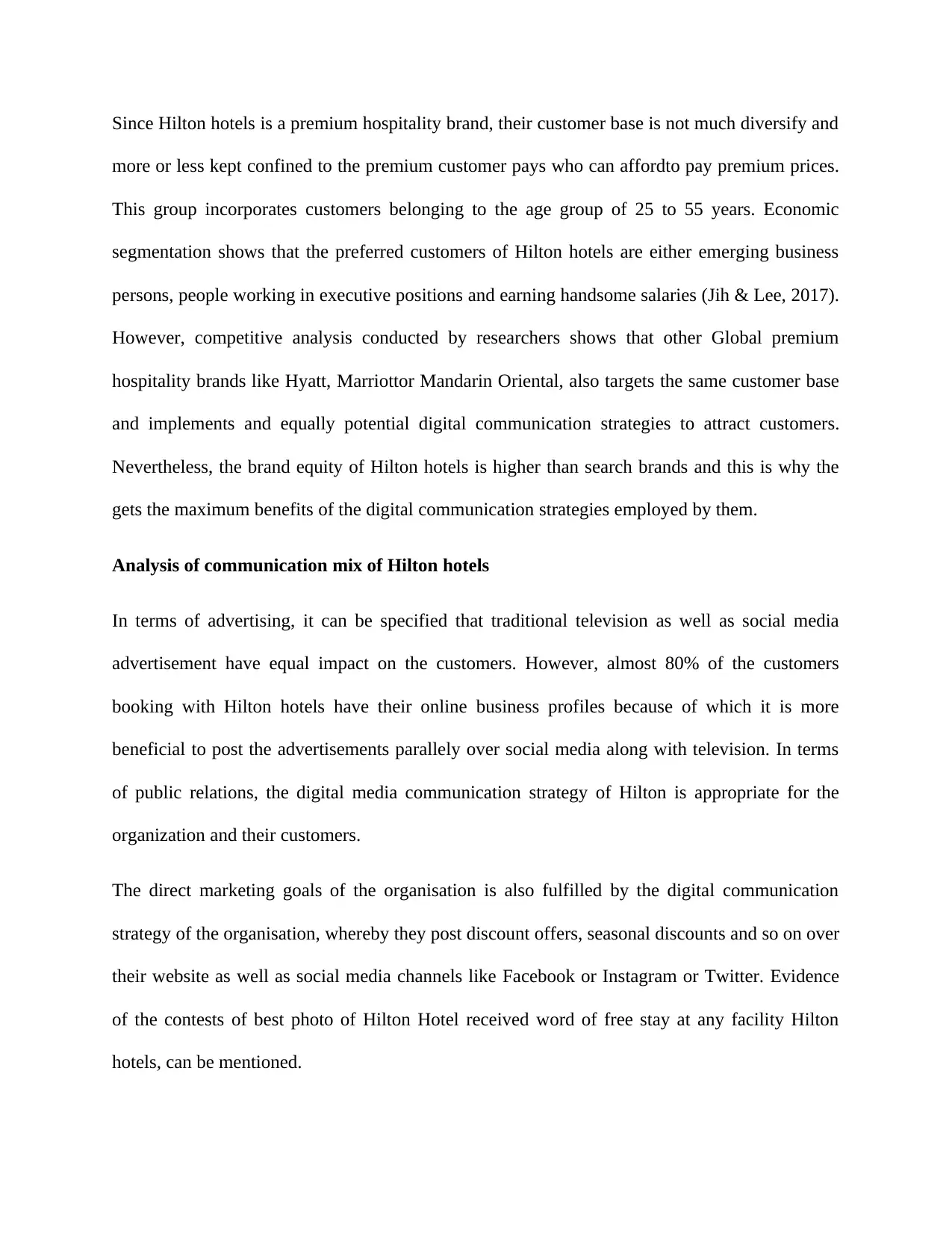
Since Hilton hotels is a premium hospitality brand, their customer base is not much diversify and
more or less kept confined to the premium customer pays who can affordto pay premium prices.
This group incorporates customers belonging to the age group of 25 to 55 years. Economic
segmentation shows that the preferred customers of Hilton hotels are either emerging business
persons, people working in executive positions and earning handsome salaries (Jih & Lee, 2017).
However, competitive analysis conducted by researchers shows that other Global premium
hospitality brands like Hyatt, Marriottor Mandarin Oriental, also targets the same customer base
and implements and equally potential digital communication strategies to attract customers.
Nevertheless, the brand equity of Hilton hotels is higher than search brands and this is why the
gets the maximum benefits of the digital communication strategies employed by them.
Analysis of communication mix of Hilton hotels
In terms of advertising, it can be specified that traditional television as well as social media
advertisement have equal impact on the customers. However, almost 80% of the customers
booking with Hilton hotels have their online business profiles because of which it is more
beneficial to post the advertisements parallely over social media along with television. In terms
of public relations, the digital media communication strategy of Hilton is appropriate for the
organization and their customers.
The direct marketing goals of the organisation is also fulfilled by the digital communication
strategy of the organisation, whereby they post discount offers, seasonal discounts and so on over
their website as well as social media channels like Facebook or Instagram or Twitter. Evidence
of the contests of best photo of Hilton Hotel received word of free stay at any facility Hilton
hotels, can be mentioned.
more or less kept confined to the premium customer pays who can affordto pay premium prices.
This group incorporates customers belonging to the age group of 25 to 55 years. Economic
segmentation shows that the preferred customers of Hilton hotels are either emerging business
persons, people working in executive positions and earning handsome salaries (Jih & Lee, 2017).
However, competitive analysis conducted by researchers shows that other Global premium
hospitality brands like Hyatt, Marriottor Mandarin Oriental, also targets the same customer base
and implements and equally potential digital communication strategies to attract customers.
Nevertheless, the brand equity of Hilton hotels is higher than search brands and this is why the
gets the maximum benefits of the digital communication strategies employed by them.
Analysis of communication mix of Hilton hotels
In terms of advertising, it can be specified that traditional television as well as social media
advertisement have equal impact on the customers. However, almost 80% of the customers
booking with Hilton hotels have their online business profiles because of which it is more
beneficial to post the advertisements parallely over social media along with television. In terms
of public relations, the digital media communication strategy of Hilton is appropriate for the
organization and their customers.
The direct marketing goals of the organisation is also fulfilled by the digital communication
strategy of the organisation, whereby they post discount offers, seasonal discounts and so on over
their website as well as social media channels like Facebook or Instagram or Twitter. Evidence
of the contests of best photo of Hilton Hotel received word of free stay at any facility Hilton
hotels, can be mentioned.
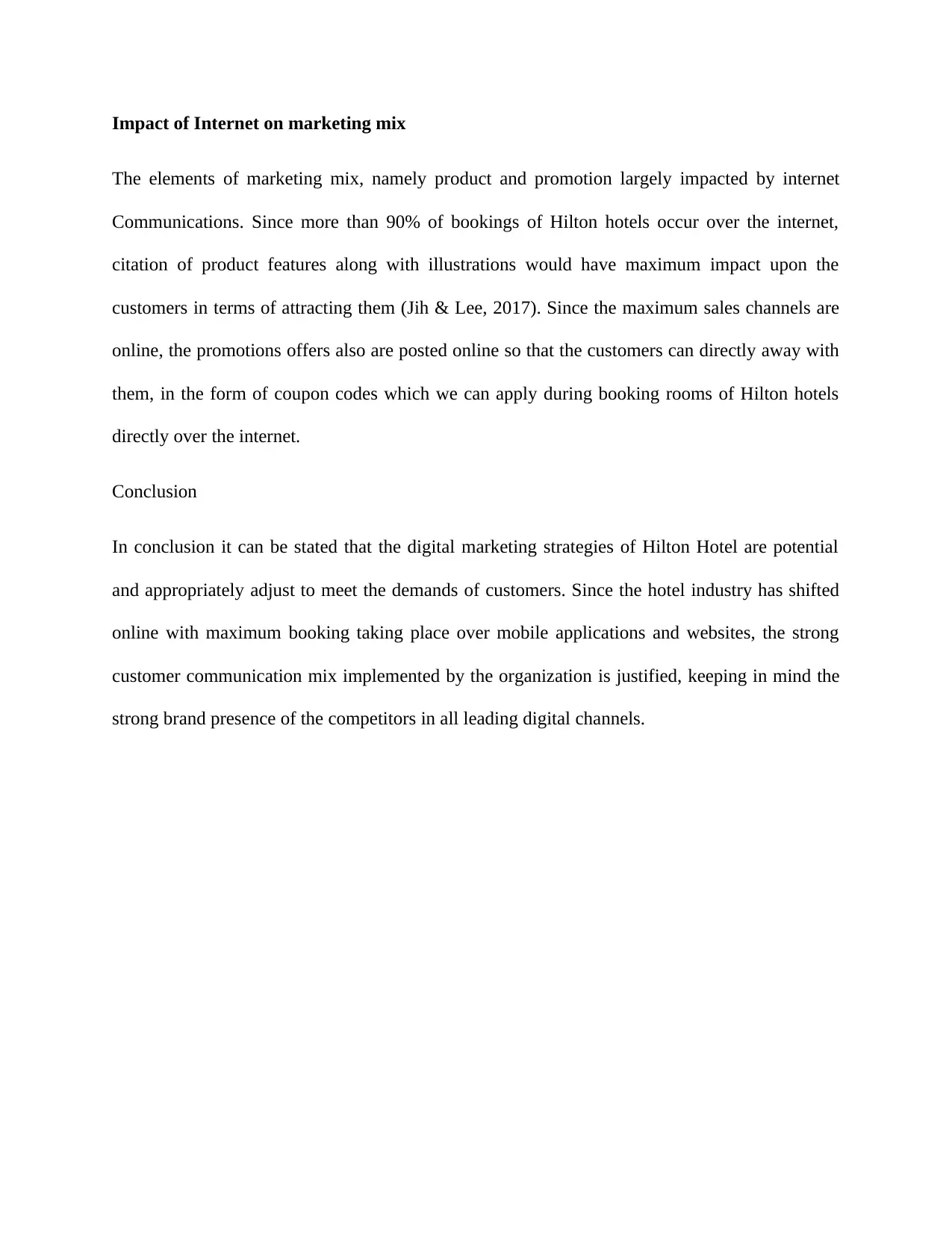
Impact of Internet on marketing mix
The elements of marketing mix, namely product and promotion largely impacted by internet
Communications. Since more than 90% of bookings of Hilton hotels occur over the internet,
citation of product features along with illustrations would have maximum impact upon the
customers in terms of attracting them (Jih & Lee, 2017). Since the maximum sales channels are
online, the promotions offers also are posted online so that the customers can directly away with
them, in the form of coupon codes which we can apply during booking rooms of Hilton hotels
directly over the internet.
Conclusion
In conclusion it can be stated that the digital marketing strategies of Hilton Hotel are potential
and appropriately adjust to meet the demands of customers. Since the hotel industry has shifted
online with maximum booking taking place over mobile applications and websites, the strong
customer communication mix implemented by the organization is justified, keeping in mind the
strong brand presence of the competitors in all leading digital channels.
The elements of marketing mix, namely product and promotion largely impacted by internet
Communications. Since more than 90% of bookings of Hilton hotels occur over the internet,
citation of product features along with illustrations would have maximum impact upon the
customers in terms of attracting them (Jih & Lee, 2017). Since the maximum sales channels are
online, the promotions offers also are posted online so that the customers can directly away with
them, in the form of coupon codes which we can apply during booking rooms of Hilton hotels
directly over the internet.
Conclusion
In conclusion it can be stated that the digital marketing strategies of Hilton Hotel are potential
and appropriately adjust to meet the demands of customers. Since the hotel industry has shifted
online with maximum booking taking place over mobile applications and websites, the strong
customer communication mix implemented by the organization is justified, keeping in mind the
strong brand presence of the competitors in all leading digital channels.
⊘ This is a preview!⊘
Do you want full access?
Subscribe today to unlock all pages.

Trusted by 1+ million students worldwide
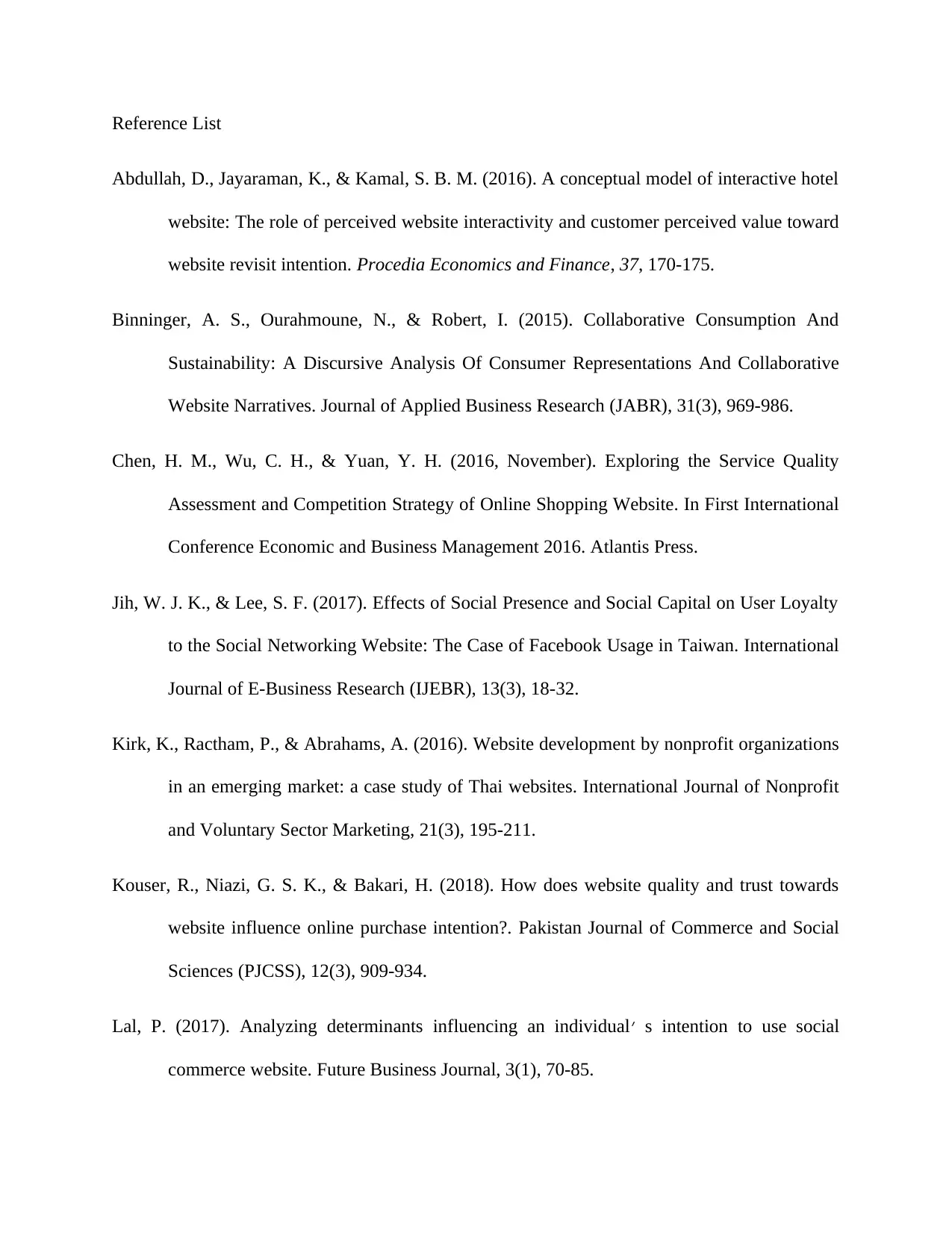
Reference List
Abdullah, D., Jayaraman, K., & Kamal, S. B. M. (2016). A conceptual model of interactive hotel
website: The role of perceived website interactivity and customer perceived value toward
website revisit intention. Procedia Economics and Finance, 37, 170-175.
Binninger, A. S., Ourahmoune, N., & Robert, I. (2015). Collaborative Consumption And
Sustainability: A Discursive Analysis Of Consumer Representations And Collaborative
Website Narratives. Journal of Applied Business Research (JABR), 31(3), 969-986.
Chen, H. M., Wu, C. H., & Yuan, Y. H. (2016, November). Exploring the Service Quality
Assessment and Competition Strategy of Online Shopping Website. In First International
Conference Economic and Business Management 2016. Atlantis Press.
Jih, W. J. K., & Lee, S. F. (2017). Effects of Social Presence and Social Capital on User Loyalty
to the Social Networking Website: The Case of Facebook Usage in Taiwan. International
Journal of E-Business Research (IJEBR), 13(3), 18-32.
Kirk, K., Ractham, P., & Abrahams, A. (2016). Website development by nonprofit organizations
in an emerging market: a case study of Thai websites. International Journal of Nonprofit
and Voluntary Sector Marketing, 21(3), 195-211.
Kouser, R., Niazi, G. S. K., & Bakari, H. (2018). How does website quality and trust towards
website influence online purchase intention?. Pakistan Journal of Commerce and Social
Sciences (PJCSS), 12(3), 909-934.
Lal, P. (2017). Analyzing determinants influencing an individual׳ s intention to use social
commerce website. Future Business Journal, 3(1), 70-85.
Abdullah, D., Jayaraman, K., & Kamal, S. B. M. (2016). A conceptual model of interactive hotel
website: The role of perceived website interactivity and customer perceived value toward
website revisit intention. Procedia Economics and Finance, 37, 170-175.
Binninger, A. S., Ourahmoune, N., & Robert, I. (2015). Collaborative Consumption And
Sustainability: A Discursive Analysis Of Consumer Representations And Collaborative
Website Narratives. Journal of Applied Business Research (JABR), 31(3), 969-986.
Chen, H. M., Wu, C. H., & Yuan, Y. H. (2016, November). Exploring the Service Quality
Assessment and Competition Strategy of Online Shopping Website. In First International
Conference Economic and Business Management 2016. Atlantis Press.
Jih, W. J. K., & Lee, S. F. (2017). Effects of Social Presence and Social Capital on User Loyalty
to the Social Networking Website: The Case of Facebook Usage in Taiwan. International
Journal of E-Business Research (IJEBR), 13(3), 18-32.
Kirk, K., Ractham, P., & Abrahams, A. (2016). Website development by nonprofit organizations
in an emerging market: a case study of Thai websites. International Journal of Nonprofit
and Voluntary Sector Marketing, 21(3), 195-211.
Kouser, R., Niazi, G. S. K., & Bakari, H. (2018). How does website quality and trust towards
website influence online purchase intention?. Pakistan Journal of Commerce and Social
Sciences (PJCSS), 12(3), 909-934.
Lal, P. (2017). Analyzing determinants influencing an individual׳ s intention to use social
commerce website. Future Business Journal, 3(1), 70-85.
Paraphrase This Document
Need a fresh take? Get an instant paraphrase of this document with our AI Paraphraser
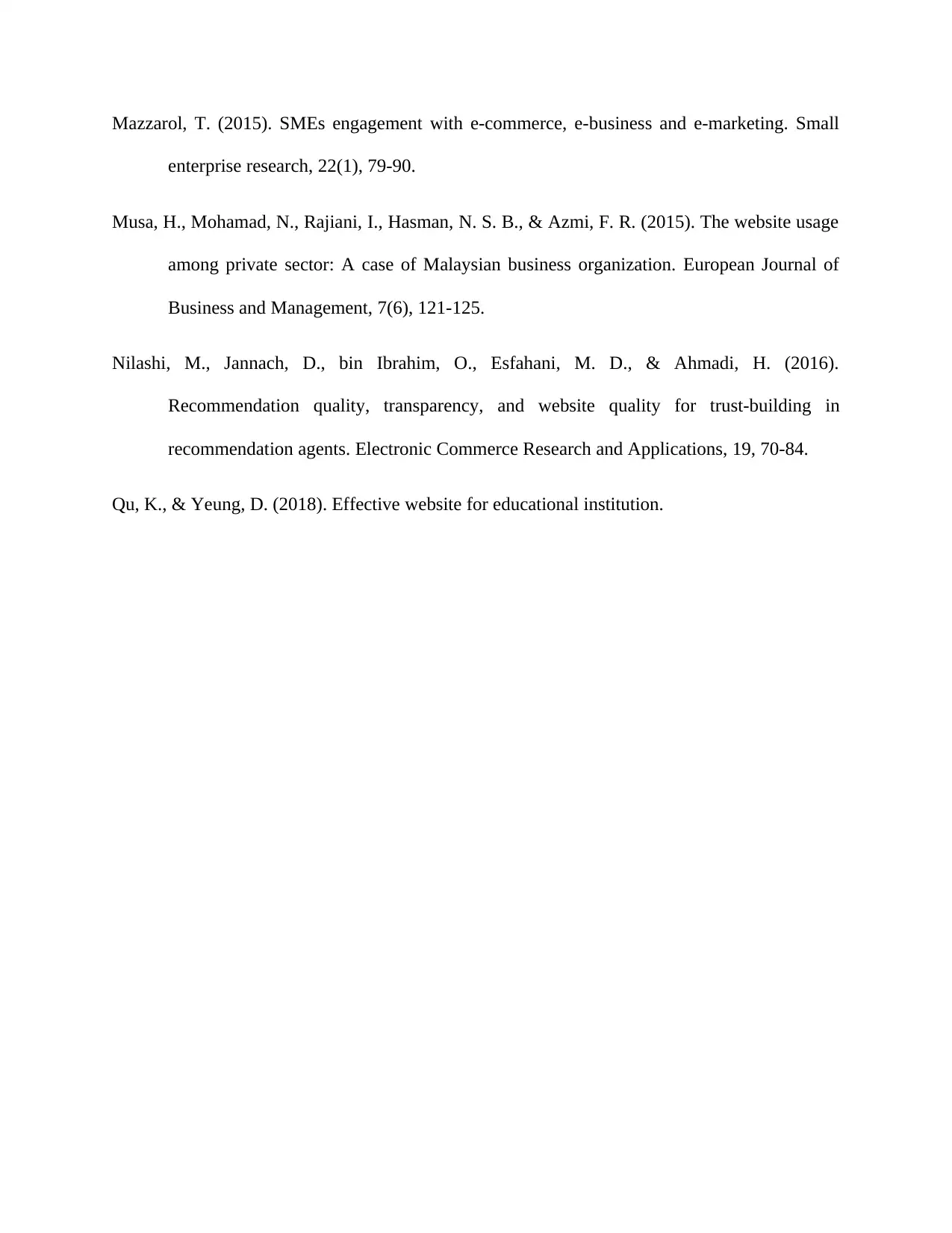
Mazzarol, T. (2015). SMEs engagement with e-commerce, e-business and e-marketing. Small
enterprise research, 22(1), 79-90.
Musa, H., Mohamad, N., Rajiani, I., Hasman, N. S. B., & Azmi, F. R. (2015). The website usage
among private sector: A case of Malaysian business organization. European Journal of
Business and Management, 7(6), 121-125.
Nilashi, M., Jannach, D., bin Ibrahim, O., Esfahani, M. D., & Ahmadi, H. (2016).
Recommendation quality, transparency, and website quality for trust-building in
recommendation agents. Electronic Commerce Research and Applications, 19, 70-84.
Qu, K., & Yeung, D. (2018). Effective website for educational institution.
enterprise research, 22(1), 79-90.
Musa, H., Mohamad, N., Rajiani, I., Hasman, N. S. B., & Azmi, F. R. (2015). The website usage
among private sector: A case of Malaysian business organization. European Journal of
Business and Management, 7(6), 121-125.
Nilashi, M., Jannach, D., bin Ibrahim, O., Esfahani, M. D., & Ahmadi, H. (2016).
Recommendation quality, transparency, and website quality for trust-building in
recommendation agents. Electronic Commerce Research and Applications, 19, 70-84.
Qu, K., & Yeung, D. (2018). Effective website for educational institution.
1 out of 11
Related Documents
Your All-in-One AI-Powered Toolkit for Academic Success.
+13062052269
info@desklib.com
Available 24*7 on WhatsApp / Email
![[object Object]](/_next/static/media/star-bottom.7253800d.svg)
Unlock your academic potential
Copyright © 2020–2025 A2Z Services. All Rights Reserved. Developed and managed by ZUCOL.





